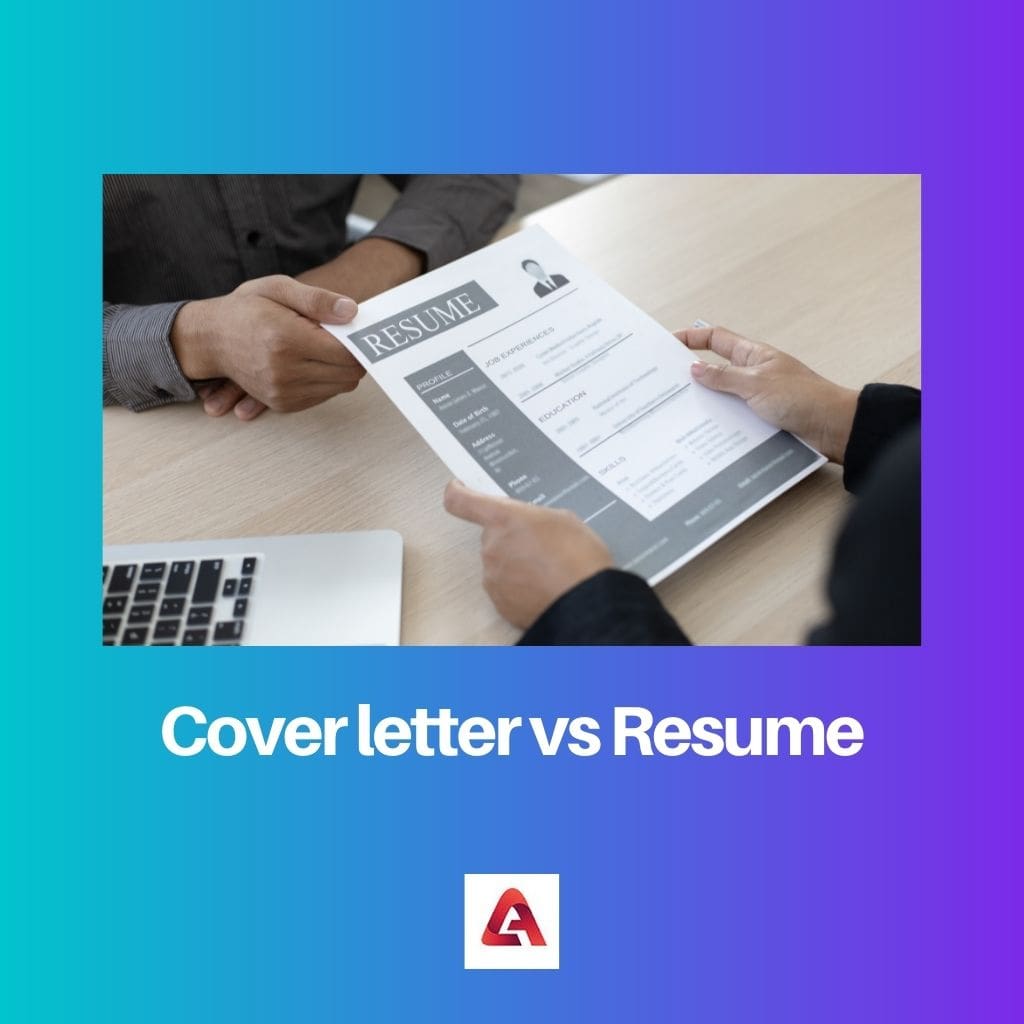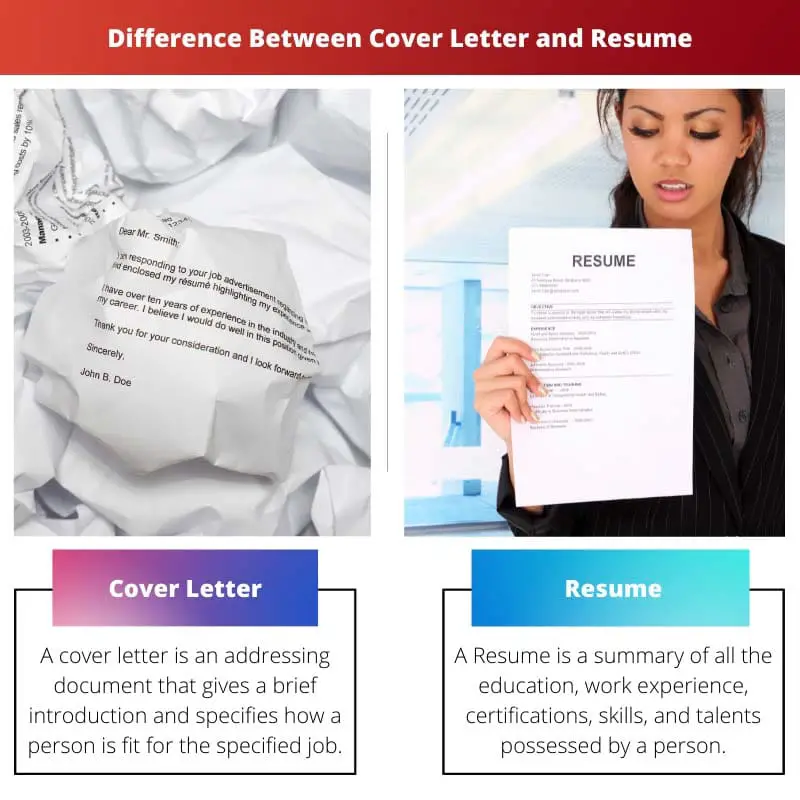A cover letter is a personalized document that introduces you to a potential employer, highlighting your qualifications, experiences, and why you’re interested in the position. It serves as a narrative complement to your resume, allowing you to delve deeper into specific achievements and career aspirations. The resume, on the other hand, is a concise summary of your education, work history, skills, and achievements, providing a comprehensive overview of your professional background and qualifications in a structured format.
Key Takeaways
- Cover letters are introductory documents highlighting an applicant’s interest in a position; resumes summarize work experience, education, and skills.
- Cover letters allow for personalization and tailored messaging for a specific role; resumes provide a broader overview of an applicant’s qualifications.
- Cover letters should be customized for each application; resumes can remain consistent across multiple job applications.
Cover Letter vs Resume
The difference between Cover Letter and Resume is that a Cover Letter is a kind of introduction or greeting before your actual resume appears and is an optional document unless specified. In contrast, resumes are the most important documents required for applying for a job, and it is not at all optional.

Cover Letters briefly introduce who you are and the position you want to apply to and gives a good reason why you think you are fit for the post.
While a resume is a detailed document which shows your complete work experience, education, skills, and other essential details required for the post.
Cover Letters are written in three-four paragraphs and are more subjective and friendly in tone.
While Resumes contain multiple headings and bullet points instead of paragraphs.
Comparison Table
| Feature | Cover Letter | Resume |
|---|---|---|
| Purpose | Introduces you and your candidacy for a specific job, highlights relevant skills and experiences, and motivates the employer to read your resume. | Summarizes your qualifications and experience to showcase your suitability for various job openings. |
| Content | Tailored to each job application, emphasizes relevant skills and achievements for the specific position, showcases your passion and interest in the company. | Provides a comprehensive overview of your work history, education, skills, and accomplishments, quantifiable achievements are a plus. |
| Length | Typically one page | One to two pages, ideally. |
| Style | Formal but personalized, persuasive tone, highlights achievements through storytelling. | Formal and concise, bullet points and keywords for easy scanning. |
| Information | Briefly mentions skills and experiences, explains how you can benefit the company, includes a call to action. | Lists skills and experiences in detail, quantifies achievements with numbers and metrics, includes relevant keywords. |
| Order | Written after you tailor it to a specific job application. | Written before applying for jobs, updated regularly. |
What is Cover Letter?
Introduction to Cover Letters
A cover letter is a formal document submitted alongside a resume when applying for a job or internship. It serves as an introduction, providing context and highlighting key aspects of the applicant’s qualifications and experiences. Unlike a resume, which focuses on summarizing one’s professional history, a cover letter offers the opportunity to personalize the application and demonstrate a deeper understanding of the position and company.
Purpose and Importance
A cover letter plays a crucial role in the job application process by allowing candidates to express their interest in a particular position and demonstrate how their skills and experiences align with the requirements of the role. It serves as a platform for applicants to showcase their personality, communication skills, and enthusiasm for the opportunity. Additionally, a well-crafted cover letter can help candidates stand out from the competition and make a positive impression on hiring managers.
Key Components
- Introduction: The opening paragraph of a cover letter should include a brief introduction of the applicant, stating the position they are applying for and how they learned about the opportunity. It sets the tone for the rest of the letter and grabs the reader’s attention.
- Body: The body of the cover letter provides an opportunity for applicants to highlight their relevant skills, experiences, and achievements. This section should be tailored to the specific job requirements and company culture, demonstrating a clear understanding of what the employer is looking for in a candidate.
- Closing: The closing paragraph should reiterate the applicant’s interest in the position and express gratitude for the opportunity to apply. It’s also an opportunity to suggest next steps, such as scheduling an interview or providing additional materials. A polite and professional closing sign-off completes the cover letter.

What is Resume?
Introduction to Resumes
A resume is a formal document that provides a concise summary of an individual’s education, work experience, skills, achievements, and qualifications. It serves as a snapshot of the candidate’s professional background and is typically submitted when applying for employment opportunities. Resumes are tailored to specific job roles and serve as a crucial tool for recruiters and hiring managers to assess a candidate’s suitability for a position.
Purpose and Importance
The primary purpose of a resume is to showcase an individual’s qualifications and experiences relevant to a particular job opening. It acts as a marketing tool, highlighting the candidate’s strengths and accomplishments in a clear and structured format. A well-crafted resume not only provides recruiters with essential information about the candidate’s background but also helps them quickly evaluate whether the candidate meets the requirements of the position.
Key Components
- Contact Information: The top section of a resume includes the candidate’s name, contact information (such as phone number, email address, and mailing address), and optionally, a professional summary or objective statement.
- Professional Experience: This section lists the candidate’s work history in reverse chronological order, starting with the most recent position held. Each entry typically includes the job title, company name, location, dates of employment, and a brief description of responsibilities and accomplishments.
- Education: The education section highlights the candidate’s academic background, including degrees earned, institutions attended, graduation dates, and any relevant certifications or coursework.
- Skills: A skills section outlines the candidate’s technical and soft skills relevant to the job, such as language proficiency, computer software proficiency, project management skills, etc.
- Achievements and Awards: This optional section allows candidates to showcase any notable achievements, awards, or recognition received throughout their career, demonstrating their capabilities and contributions.

Main Differences Between Cover Letter and Resume
- Purpose:
- Cover Letter: Introduces the applicant, expresses interest in the position, and provides context for the application.
- Resume: Summarizes the applicant’s education, work history, skills, and achievements in a structured format.
- Content:
- Cover Letter: Personalized narrative highlighting specific experiences, qualifications, and motivations relevant to the job.
- Resume: Concise summary of educational background, work experience, skills, and accomplishments, typically in reverse chronological order.
- Length and Format:
- Cover Letter: Typically one page in length, written in paragraph form with a formal tone.
- Resume: Can vary in length but is generally limited to one or two pages, organized into sections with bullet points for clarity and brevity.
- Customization:
- Cover Letter: Tailored to each job application, addressing specific job requirements and company culture.
- Resume: May be customized to emphasize relevant skills and experiences for different job opportunities, but the overall format remains consistent.
- Function:
- Cover Letter: Provides context and a personal touch to the application, helping the applicant stand out and demonstrating their enthusiasm for the position.
- Resume: Serves as a comprehensive summary of the applicant’s qualifications and experiences, allowing recruiters to quickly evaluate their suitability for the job.

- https://go.gale.com/ps/i.do?id=GALE%7CA17198638&sid=googleScholar&v=2.1&it=r&linkaccess=abs&issn=07497075&p=AONE&sw=w
- https://www.ncbi.nlm.nih.gov/pmc/articles/PMC3207534/
- https://www.jstor.org/stable/43095873https://www.federalreserve.gov/pubs/Bulletin/2004/summer04_credit.pdf

The article’s explanation of the difference between cover letters and resumes is misleading. It presents subjective information as fact, which can be misleading for job applicants.
I see what you mean, there should be more clarity on this issue.
The article’s detailed breakdown of the key differences between cover letters and resumes is really useful for those entering the job market.
I completely agree. This article provides valuable insight into these crucial aspects of job applications.
The article provides an illuminating discussion of cover letters and resumes. The comparative analysis effectively highlights their respective attributes and differences.
Absolutely, the comparison table is particularly informative in clarifying the distinctions between cover letters and resumes.
The article presents a coherent explanation of cover letters and resumes. The comparison table is particularly insightful.
I found the table to be very helpful in distinguishing the key features of cover letters and resumes.
While the article provides a comprehensive overview of cover letters and resumes, it lacks a detailed exploration of potential drawbacks associated with these documents.
Agreed, presenting both the advantages and limitations would result in a more comprehensive understanding of the subject.
That’s a valid point. A more critical analysis would provide a more balanced view of the topic.
This article effectively emphasizes the importance of cover letters and resumes during the job application process.
Indeed, the article makes a compelling case for the value of cover letters and resumes.
Absolutely, understanding the significance of these documents is fundamental for job applicants.
This article provides a clear and concise explanation about cover letters and resumes, and why they are important during job application processes. The comparative table is really useful as well.
I agree, the table makes it easy to understand the differences between cover letters and resumes.
The detailed description of the role and importance of cover letters and resumes is extremely beneficial for job seekers.
Definitely, having a clear understanding of these documents can greatly improve an individual’s job application prospects.
I appreciate the in-depth analysis of cover letters and resumes. The article effectively communicates the importance of each and why they are necessary for job applications.
Agreed. This article provides a comprehensive understanding of these documents.
The article presents an insightful and well-structured analysis of the importance of cover letters and resumes. Definitely a useful resource for job seekers.